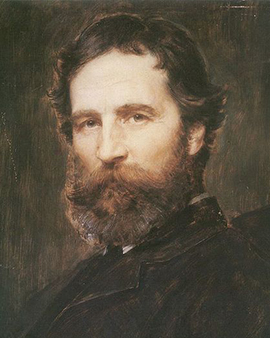


Franz Defregger had something very special planned for his life. As the son of a farming family, he planned to sell the house and farm as soon as he inherited it. Franz wanted to share the proceeds with his two sisters. Franz Defregger wanted to leave the familiar behind. America dominated the desires of the young man who had broken away from the possessions to which he had been tied. Franz Defregger's dream came to nothing, so he returned to his native Bavaria and began training as a sculptor in Innsbruck. A far-reaching decision, because from now on art was to become his life's purpose and help him to fame, reputation and a considerable fortune.
Franz Defregger is considered an artist of the Munich School. Despite the fact that the painter deepened his studies in Paris, he remained closely associated with the Royal Academy in Munich. Under the reign of Ludwig I, the academy developed into a centre of European art until the 20th century. The Munich School stands for the ideal of perfect imitation of reality, which has existed since Aristotle. The works are naturalistic and belong to the genre of landscape painting and often have a historical reference. Franz Defregger preferred to devote himself to motifs that had been familiar to him since childhood. He captured the life of the farmers in Tyrol with great sensitivity. The viewer senses that the artist did not perceive the motif as an outsider. Each figure shows individual characteristics, a feature that also stands out in the numerous portraits. Faces with signs of life, wrinkles, shotguns, pipes and carefully draped cloths, are hints that show the person behind the portrait. In addition to peasant scenes, Defregger worked on historical events. The Tyrolean popular uprising of 1809 is a recurring element in his work. Expressive, without pathos and the monumental grandeur of earlier history paintings, Franz Defregger stages the experiences and gets to the heart of what happened.
The painter Franz Defregger moved his center of life to Munich. Together with Gabriel Cornelius Ritter von Max and Hans Makart he worked for the studio of Karl Theodor von Piloty for several years. Piloty was not only a history painter, he was also professor and director of the Royal Academy of Arts and one of the leading forces, the promotion of art. In Munich, a close circle of artists and mentors developed who were looked upon favorably by royalty. Defregger's paintings sold quickly. For his historical depictions, the painter received the Order of Merit of the Bavarian Crown and was raised to the rank of knight. Franz Defregger had a private house in Munich and a residence in Bolzano. Defregger managed to earn a fortune in the millions with his work. During Defregger's lifetime the copyright for artists was decided in its basic features and is certainly one of the reasons for the great wealth of the painter.

Franz Defregger had something very special planned for his life. As the son of a farming family, he planned to sell the house and farm as soon as he inherited it. Franz wanted to share the proceeds with his two sisters. Franz Defregger wanted to leave the familiar behind. America dominated the desires of the young man who had broken away from the possessions to which he had been tied. Franz Defregger's dream came to nothing, so he returned to his native Bavaria and began training as a sculptor in Innsbruck. A far-reaching decision, because from now on art was to become his life's purpose and help him to fame, reputation and a considerable fortune.
Franz Defregger is considered an artist of the Munich School. Despite the fact that the painter deepened his studies in Paris, he remained closely associated with the Royal Academy in Munich. Under the reign of Ludwig I, the academy developed into a centre of European art until the 20th century. The Munich School stands for the ideal of perfect imitation of reality, which has existed since Aristotle. The works are naturalistic and belong to the genre of landscape painting and often have a historical reference. Franz Defregger preferred to devote himself to motifs that had been familiar to him since childhood. He captured the life of the farmers in Tyrol with great sensitivity. The viewer senses that the artist did not perceive the motif as an outsider. Each figure shows individual characteristics, a feature that also stands out in the numerous portraits. Faces with signs of life, wrinkles, shotguns, pipes and carefully draped cloths, are hints that show the person behind the portrait. In addition to peasant scenes, Defregger worked on historical events. The Tyrolean popular uprising of 1809 is a recurring element in his work. Expressive, without pathos and the monumental grandeur of earlier history paintings, Franz Defregger stages the experiences and gets to the heart of what happened.
The painter Franz Defregger moved his center of life to Munich. Together with Gabriel Cornelius Ritter von Max and Hans Makart he worked for the studio of Karl Theodor von Piloty for several years. Piloty was not only a history painter, he was also professor and director of the Royal Academy of Arts and one of the leading forces, the promotion of art. In Munich, a close circle of artists and mentors developed who were looked upon favorably by royalty. Defregger's paintings sold quickly. For his historical depictions, the painter received the Order of Merit of the Bavarian Crown and was raised to the rank of knight. Franz Defregger had a private house in Munich and a residence in Bolzano. Defregger managed to earn a fortune in the millions with his work. During Defregger's lifetime the copyright for artists was decided in its basic features and is certainly one of the reasons for the great wealth of the painter.
Page 1 / 1






